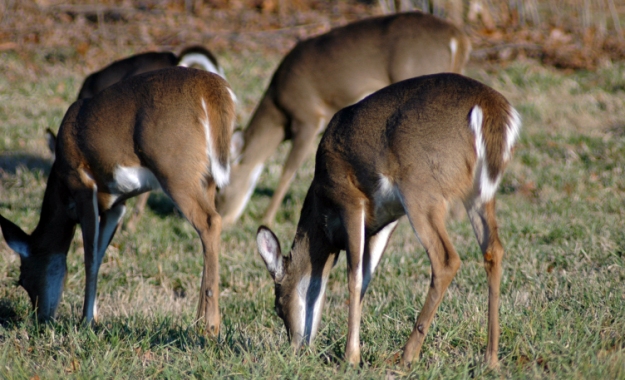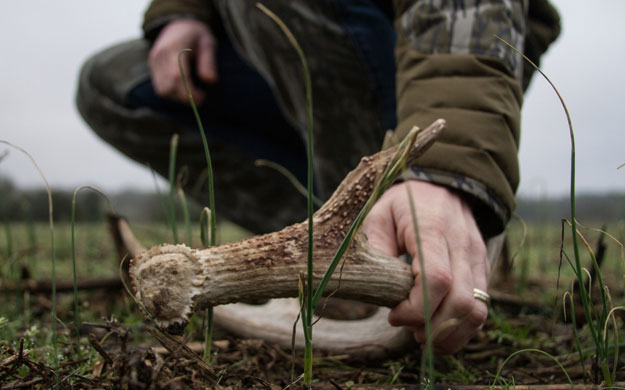
Since Alabama deer hunters can harvest 121 deer per season, per hunter, many sportsmen who hunt deer in states that don’t have limits as liberal as Alabama don’t understand why Alabama deer hunters don’t totally decimate the deer herd. But the average deer hunter in Alabama historically only has harvested 1-1/2 deer per season. You may ask, “With the liberal limits Alabama has, why are so few deer being taken?” On the 1,800 acres my friends and I manage in Perry County, we usually won’t take more than two mature deer, if that many each season. Like any hunting lease, we have a few bucks that we classify as cull deer - a deer that may weigh 200+ pounds but is only a 5 or a 6 point. We allow our children to take those deer. In the last 3 years, we've harvested two or three mature bucks, with one scoring 149-6/8. Another one scored 148 and some change, and yet another one scored close to 150. We have trail-camera pictures of bucks that are much bigger than those, but we call these bucks our ghost bucks, because those bucks are very smart and very difficult to find and hunt.
We have 12 green fields from 2-5 acres each on the diverse property we hunt. We have about 80 acres of agriculture for the deer to feed on like planted corn, planted soybeans and other types of agriculture and another 500-600 acres of Conservation Reserve Program (CRP) land. The rest is timber with some pine timber on our ridge tops. We have 14 shooting houses, 10 fixed-position stands to bowhunt from, and three, 2-man ladder stands, so parents can hunt with their children.
Overlooked Secret to Trophy-Buck Management:
I believe the critical factor, and this is one of the most important factors in trying to manage our land for trophy bucks, is that all of our hunters have grown up and hunted in south Alabama. Because of the overpopulation of deer we've always had in south Alabama, each one of our six members probably has taken more than 100 deer in their lifetimes. Therefore, we don’t feel nearly as much pressure to take a doe or a buck as a person does who lives in a state where they only may be able to harvest one buck per season and either no does or only three to five does. I believe that the real secret to managing any property for older-age-class bucks depends on the number of deer that the hunters who hunt a particular land have taken in their lifetimes. As I mentioned, when I hunted near my home in my younger days, any buck was a good buck, because we saw so few of them. But because we've all reached our limit for the number of bucks we want to take, we don’t feel like we have to take a buck, unless he is the age with the size rack that we want to take. We understand that trophy management shouldn’t be the standard that all hunters hope to achieve, because they still may be in a state where any buck is a good buck.
 Another limiting factor in managing land for trophy deer is the quality of soils that you have on the land you hunt. The soils in Perry County and 15+ counties in central and south Alabama are known as the Black Belt and are much-more fertile than the soil in the rest of south Alabama. The soils in the Black Belt are known for growing many more big bucks quicker than the soils in the lower section of the state. For this reason, if you have poor soils on the land you hunt, the likelihood of growing bigger bucks with larger antlers isn’t as good as when you have extremely fertile soils. The fertility of the soil is directly related to a landowner or a hunting club’s ability to produce older-age-class trophy bucks. That’s why I know that the type of trophy deer management we’re using on our lease isn’t the kind of deer management hunters in other sections of the country should attempt to duplicate.
Another limiting factor in managing land for trophy deer is the quality of soils that you have on the land you hunt. The soils in Perry County and 15+ counties in central and south Alabama are known as the Black Belt and are much-more fertile than the soil in the rest of south Alabama. The soils in the Black Belt are known for growing many more big bucks quicker than the soils in the lower section of the state. For this reason, if you have poor soils on the land you hunt, the likelihood of growing bigger bucks with larger antlers isn’t as good as when you have extremely fertile soils. The fertility of the soil is directly related to a landowner or a hunting club’s ability to produce older-age-class trophy bucks. That’s why I know that the type of trophy deer management we’re using on our lease isn’t the kind of deer management hunters in other sections of the country should attempt to duplicate.
The other factor that the members of our lease consider before squeezing the trigger on their mechanical release if they're bowhunting or squeezing the trigger on their rifle is the age of the deer. On the second week of bow season in Alabama, a buck with antlers that would score about 136 inches on Pope & Young walked under my tree stand. This buck was a main-frame 9 point and was with a nice 7 point. The 9-point buck was only about 4-1/2 years old. Since I knew that he had the potential of becoming a giant, I let him walk. I really believe that 99 percent of Alabama bowhunters would have shot that 9-pointer with their bows, and would have been very, very proud of that deer. However, the members of our lease only want to shoot older-age-class bucks. I believe that within 2-3 more years, that 9-point has the potential to be a real giant. So, the best deer management for your club boils down to the size bucks you and the people you hunt with want to harvest. Because I've taken more than 100 deer in my lifetime and will pass up a 4-year-old buck that will score 136 inches doesn’t mean that our type of deer management is better than the type of deer management you and your friends use on the property you hunt. In many parts of the nation, a bowhunter never may have the opportunity in his lifetime to see or take a 130-plus-inch buck. That’s why I say quality deer management and/or trophy deer management isn’t for everyone.
For more information on Alabama’s deer hunting, go to http://outdooralabama.com.
Day 2: A Management System for Overpopulated Deer Herds
Tomorrow: Biologist Bill Gray on What’s the Best Deer Management Plan for Alabama’s WMAs



























